From brand awareness to reach, TV advertising achieves multiple goals. But most marketers find it hard to measure the impact on website and online shop traffic - and therefore on sales.
I am sure that most marketing executives will agree that it's a real struggle to find the right TV attribution strategy. From tech to analytics, there are many challenges to do this right.
Here is the good news: it's easier than you think to measure the impact of TV spots on your traffic. In this blog post, we are going to analyze how you can fix your TV measurement and improve your investments.
Over the past two decades, there has been an emergence of new advertising mediums into the digital era. It is now unclear if TV ads are still relevant. This has raised the question: “Should you reallocate TV advertising funds elsewhere?”
Advertisers have praised TV for its incredible reach, but it is no secret that it can be very difficult to track and maximize efficiency. But this is no longer the case.
Don’t let headlines fool you. TV is not dead!
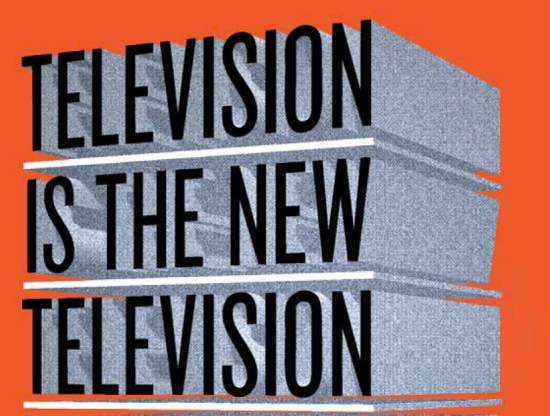 (source)
(source)
It is still the #1 source of media consumption.
One can argue that digital advertising sources have many advantages. For instance, they can be thoroughly targeted, quickly analyzed and easily optimized. Fortunately, this is now possible for TV.
While the total global ad spend on digital advertising overtook TV some time ago, TV is still a large. Actually, very large. According to the latest study from Zenith, TV budgets still exceed search, social media and video ads by over 40 billion dollars. This puts it at the forefront of ad spend by type.
For big spenders, TV is a must-do category. There is no mainstream campaign that excludes TV media buying. Reach on prime time is still massive. The super bowl still attracts a lot of eye-balls. Lots of people still spend a lot of time in front of their screens. Of course, the delivery and consumption of TV content has changed.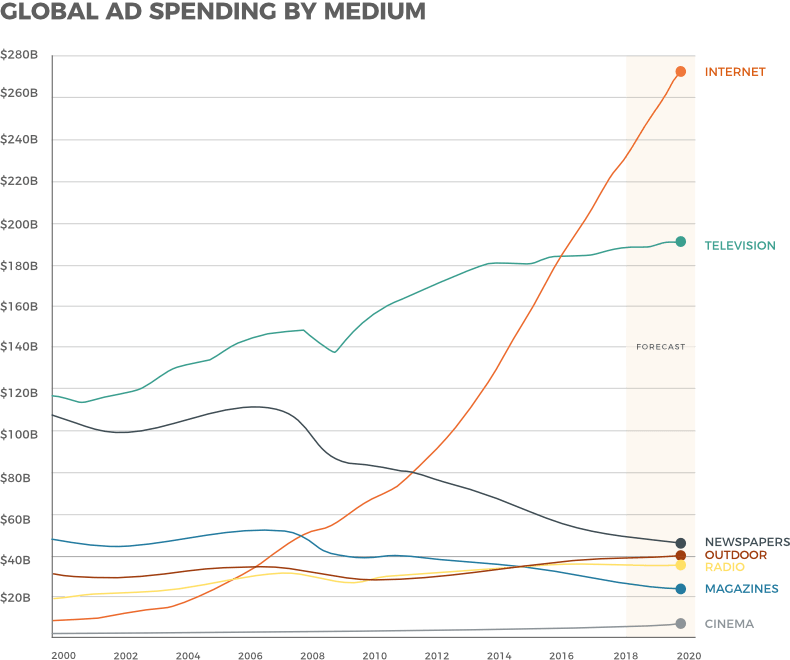
According to Zenith, people spend an average of 170 minutes every day watching TV. A global audience transitioned from TV to digital entertainment within a few years. Although everyone expected this change, it happened much faster than anticipated.
Zenith predicted that TV would still be more popular in 2019 but has since revised its estimates.
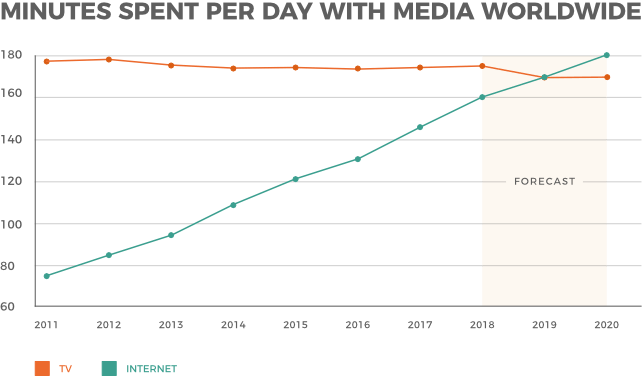
TV consumption does have a few outliers with Americans leading the pack in daily hours watching TV. The Atlantic summed it up quite nicely: “Americans still watch an absolutely astounding amount of traditional television.
In fact, television viewing didn’t peak until 2009-2010. At this point, the average American household watched 8 hours and 55 minutes of TV per day. Over the last 8 years, all the new, non-TV things, from Facebook, phones, YouTube, Netflix—have only cut about an hour per day from the dizzying amount of TV that the average household watches.
Americans are still watching more than 7 hours and 50 minutes per household per day.”
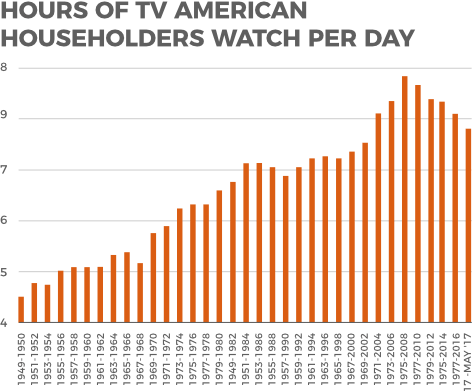
The Atlantic continues: “Even though phones have pulled attention into this new kind of glowing rectangle to do new things, TV remains the biggest monopolizer of Americans’ attention. Whatever else we might say about Facebook as an ever-optimizing attention-mining machine or the clickbaity excesses of YouTube, Americans still watch as much TV as they did before the creation of Facebook, YouTube, and Netflix.”
This development can be interpreted differently when splitting data between age groups. In most parts of the developed world, the demographic change is happening fast. Japan and Italy have the oldest populations with 26.3% and 22.4% of citizens being older than 65 years old. While TV consumption in this age group continues to grow, younger audiences are watching less TV than ever.
Marketingcharts provided their own analyses of this chart:
- Both teens and young Millennials have seen their traditional TV viewing decline by more than 40% over the past 5 years. While teens are reducing their viewing time by almost half.
- More still, teens’ traditional TV viewing time fell by almost 20% in a single year.
- A similar trend has also been observed in older millennials. The time they spend watching traditional TV has reduced by one-third in the past 5 years.
- The oldest age bracket (65+) have shown declining TV consumption in only three of the last 20 quarters.
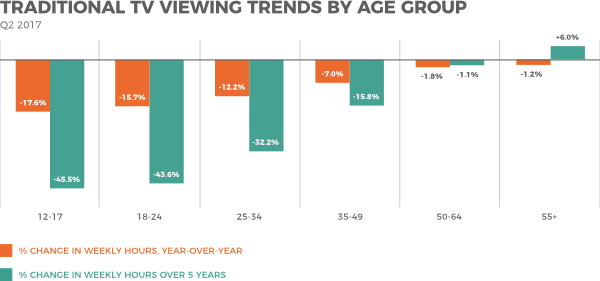
In conclusion, TV still gets attention from many eyeballs, which is why marketers still spend a lot on this category.
Tom Goodwin has a strong opinion on this development: "The TV market, in terms of advertiser money, is growing globally, especially in the UK and US. Part of that is driven by scarcity, which is a strange thing with TV. The harder it is to reach people on TV, the more expensive the slots become. The big moments, like the Oscars and sports championships, have become more fleeting, so those must-see TV moments have become greater in value because they are so rare.
For example, for P&G there’s no other way to reach 30 million people than through the Super Bowl. But 20 years ago, you could’ve done that through an episode of MASH. On the internet, it’s the exact opposite; the most time spent, the more ad impressions created and the lower the price goes."
While self-service buying and programmatic ads are the new reality in digital marketing, TV still waits for the big programmatic disruption from the advertising industry. While there have been many failed attempts made throughout the years, many people still expect this to happen soon.
Coming back to the present time. One big question for many marketers relates to the best method for assessing the performance of TV campaigns.
Many FMCG marketers know that TV moves the needle. Sales proves it. Still, in today’s data-driven world we should be able to prove what any given campaign brings to the bottom line.
Remember: you can only manage and optimize what you're able to measure.
While an increase in sales is welcome news, there will always be a burning question. “Is this the best we could have done or is there untapped potential to optimize our TV campaigns further?”
We are now a step closer to helping TV advertisers and media agencies better measure the performance of TV advertising. Particularly, its impact on immediate and long-term website traffic.
![]()
In theory, this exercise sounds super easy. Measuring the effect from TV on your website traffic should be to easy to do. Well, not so fast.
The biggest spenders on TV are FMCG companies with large budgets, a huge product-line, multiple campaigns and target groups. There might be dozens of spots during prime time on various channels. They all have the same goal: driving viewers to a website.
You get the message. Measuring this accurately might be more complicated than first thought. Fortunately, we're here to help.
"We are very proud to offer our clients an innovative way to analyze their TV campaigns. Traditionally, this domain was covered by standalone platforms, but is now an integrated package in our platform. It doesn't matter if you or your clients are focused on brand awareness or driven by performance numbers. Everyone will now be able to analyze the measurable impact of TV on your digital numbers within Adverity."
Alexander Igelsböck, CEO Adverity
Most web analytics tools - like Google Analytics, Econda and many others - offer traffic statistics according to hourly time slots. This is clearly not sufficient for such a time-sensitive objective. We require the best data quality for this exercise.
So, if you were looking for web analytics service that offers traffic stats by the minute, you’ve found yourself the right platform.
Defining the right KPI is not a trivial task in this case. We need to observe the subsequent increase in traffic resulting from people who watched your TV ad. It would make sense to look for visits that occur immediately after your spot was running.
To be more precise, there could be a baseline set of six minutes before and after your spot. As a result, every visit above the average level of traffic will be attributed to your TV campaign. By mapping your media plan according to these traffic spikes, you can then attribute each uplift to a specific spot.
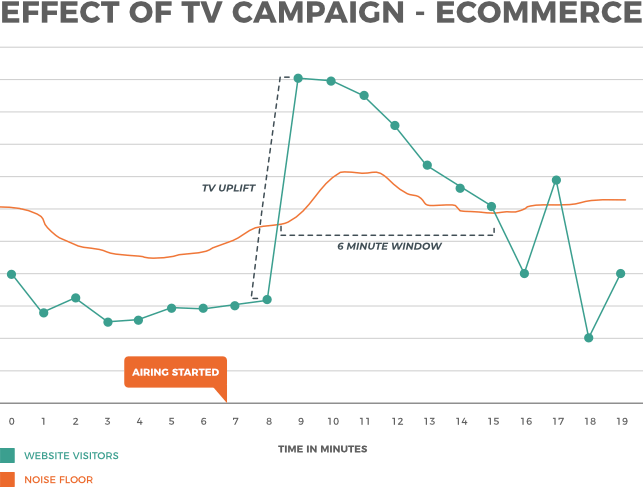
The stronger your call-to-action (CTA) in your ad is, the more people will come to your website. E-commerce companies announcing a tempting offer on TV tend to see the strongest impact from their campaign.
Analyzing and attributing specific uplifts to any given spot will give you (or your client) a great indication of whether your advertising had been well-received by its audience. More specifically, whether your demographic targeting was on point, if the message was clear and resonated with visitors, and how you might be able to further optimize your campaigns. For instance, by identifying which television channels have the best impact and the optimal ad airing times.
What type of intelligence do you get from this kind of analysis?
.png)
After observing some spikes in your traffic, you then have the possibility to measure various relative KPIs. For example, the Cost-Per-Visit or - later in the customer journey - the Cost-Per-Acquisition per day.
Depending on your goals, you'll be able to take quicker actions as a result of having these analyses at your disposal. In turn, you will better understand where your most cost-efficient website visitors come from - and when they come.
But remember to cross-reference these numbers with the average revenue that these visitors bring to your store. Perhaps, your return on investment is higher for more expensive visitors.
A visual representation of the most important KPIs can be hugely valuable. They can help identify the tops and flops of your campaign - and provide feedback to help better shape future TV investments.
How do you keep the audience data clean?
There are a few tweaks that you can implement that will ensure data will remain clean. By implementing the following actions, you'll be able to produce a realistic picture of your performance:
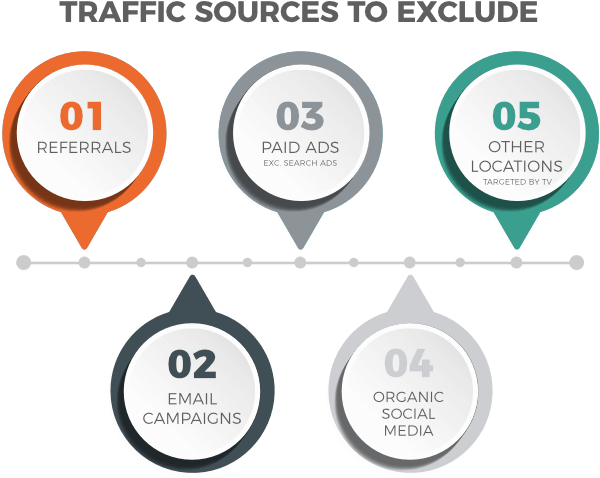
From our experience, the traffic from your social media profiles increases in this measurement period, too. The explanation is very easy. People not only perform their searches in search engines like Google, Bing and DuckDuckGo. They also use Facebook, Twitter or Pinterest. It's possible they may also click through on a retailers’ page before coming to your website.
Even though those visitors might be influenced by the TV campaign, we actually don’t know this for sure. So we advise our clients to exclude all this traffic to have clean and comparable data.
So, what traffic is considered ‘relevant’?
- Direct traffic
- Organic Search
- Paid search - we will talk about this later again
You may ask, "is there a way to increase the data quality?". We'd advise you to enrich your datasets with official viewing statistics from the national body (e.g. Nielsen in the US, BARB in the UK, Focus in Austria). This way, you can blend viewer data with your website traffic - allowing you to create a new KPI (“Cost per uplifted person”) and optimize future bookings according to most effective programming and channels.
What are the potential traps with this measurement approach?
As you might have guessed, this analysis is an extra data point to prove the effectiveness of your campaigns. If your only goal is to drive traffic to your website, TV can be a great method of doing so. That said, it might not be the most efficient method.
Nevertheless, your primary goal should be increasing brand awareness and brand recognition. So if you’re planning on measuring the effect your TV campaigns have on your website traffic, make sure you think about these three potential traps:
- Manage the expectations of your clients and/or leadership team. The potential impact of TV campaigns on your web audience might not be so easy to measure. Similarly, it might not reach a level that will convince them to maintain their investment. That does not mean that the media buying strategy is wrong.
- Data quality: think of the traps we’ve written about and be sure to use the highest quality data available. You will never be 100% sure that your uplift is from TV only. Your best chance of producing accurate analyses is to use highly granular and cleaned datasets.
- Too many advertising spots occurring at the same time will ruin your analytics. If you want to analyse each spot individually, make sure you remember to include this in your programming (or your agency briefing).
Most likely, you will have to add more data points to your analysis and create a model for the right multi-touch-attribution. The vast amount of online and offline channels increase your possibilities but also throw some challenges at you. One of them is: finding the true driver of your campaign success. Make sure to invest time and resources to find the right product to measure your multi-touch-attribution.
What’s next?
Make sure you act on the findings from your analytics. Measuring is one thing - making sure you derive the maximum possible insight is the holy grail of marketing analytics. One way to assess the visitors from your TV campaign is to create a funnel and analyze the behavior of this segment after the campaign:
- How many visitors in total were there?
- How many people subscribed to your newsletter and/or created an account?
- From those, how many added products to their shopping cart?
- How many sales did you receive from these people?
- How many returning customers do you get?
In short, try to learn as much as possible about your campaigns, bookings and target groups.
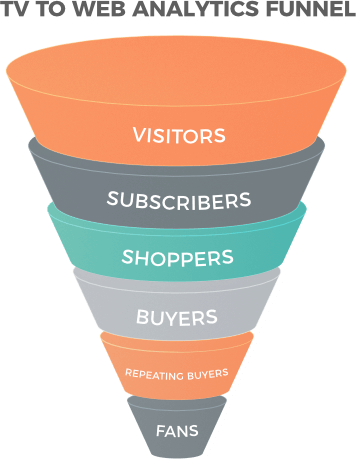
What other mediums can be measured with this method?
Like your TV campaigns, you can measure the impact of your radio campaigns. No surprise, it works exactly the same way. You can upload your media plan to our platform and measure the effectiveness of your ad spend and the uplift you receive from every single spot: by day, by creatives etc.
Furthermore, it's possible to measure the effect on your mobile app performance. This includes how it’s being used, the number of installs, search queries, launches, and conversions.
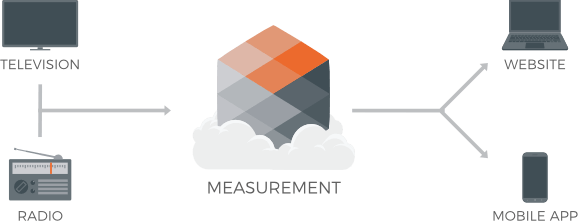
How to augment your TV campaign with paid search ads:
You can expect to receive more search queries on your brand name once your TV advertisements are running. That’s what all the big campaigns have in common and why it makes sense for you to support your TV campaigns with paid search ads. The best practices for this practice include:
- TV viewers might not remember your brand name correctly. Include additional similar sounding (or spelling) variations within your brand keywords. This will ensure that you capture all the people attempting to find you.
- Using a catchy song? Reflect this in your search strategy and include the most prominent words from the lyrics in your keyword list. Example: “Hit me baby one more time + tv advertisement” -> your search ad
- Similarly, reflect on the story, character, actor or punchline. Bidding on a search term like “Arnold Schwarzenegger mobile game” will be worth your investment. Well, assuming you are the marketer for this mobile game)
- Some people might only remember your call to action. If this has not been done yet, reflect this in your search engine marketing strategy, too.
- Last but not least, your call-to-action could be to make people search for a specific term. Dyson performed an interesting A/B test that used this strategy. They found a 1.4x increase in searches than the control ads containing the website URL.
To fully capitalize on the potential success of paid search, you should produce a landing page that’s in-line with your TV and search ad message.
How to target your competitors TV campaigns with paid search ads:
It is possible to target your competitor’s TV campaign with the exact same tactics as described above. The prerequisite: you have to be fast. When your competition is airing ads, you can bid on their keywords relating to their company and redirect this search traffic to yours. Cheeky but effective.
Our final piece of advice for this analytical piece of art would be to measure the direct actions taken by those who observed campaigns containing strong CTAs. Be mindful of how these numbers only represent one aspect of your TV creative. The long-term impact a campaign has on your brand awareness is a completely different consideration.
But once you know that a considerably higher number of people arrived from one particular source, then your next steps might be clearer.











